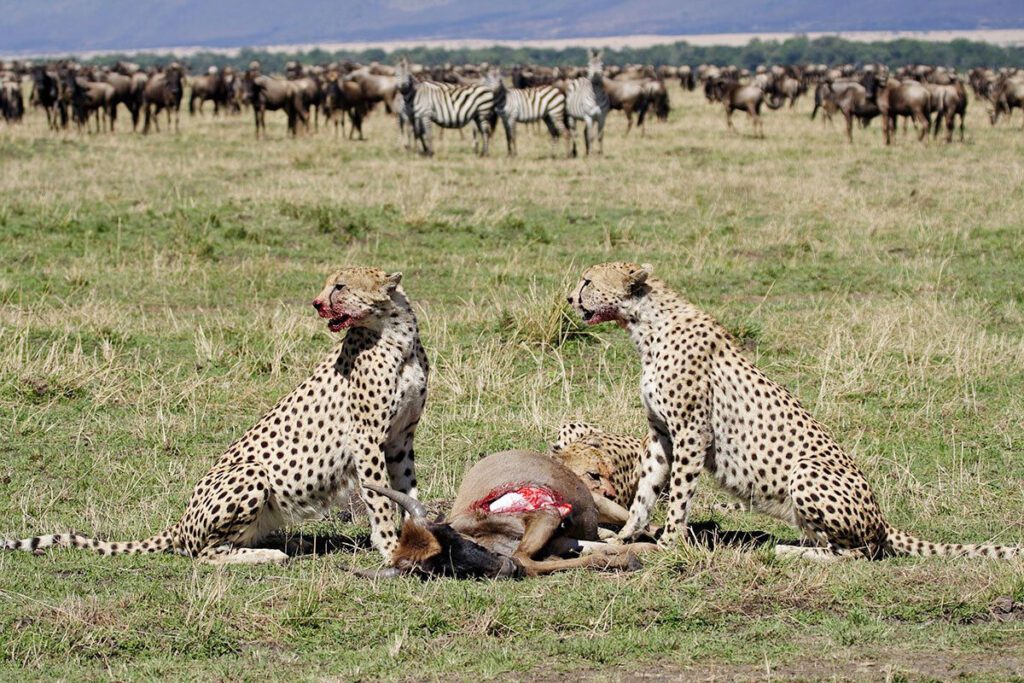Tanzania is an East African country, popular for her exciting safari destinations and wildernesses. The country is a gateway to the gigantic Indian Ocean with captivating beaches that showcase breathtaking blue waters and the white sands at the coast. Tanzania is a home to the highest mountain on the African continent and also hosts the great wildebeest migration that attracts masses from all corners of the world.
The warm and unique cultures of the country and its local people further make the country a good place to go for safaris due to exciting experiences provided while in their land.
Wildebeest migration safaris in Tanzania
Tanzania, especially the northern region is dominated by dry Savannah grasslands which are a favorable grazing ground for wildebeests and other animal species. Wildebeests usually migrate between southern Kenya and northern Tanzania in the national parks of Masai Mara and Serengeti respectively. Thousands of wildebeests migrate in search for water and greener pastures in between the two national parks.
It is in this time that travelers get the opportunity to observe these wildebeests in large numbers alongside other animals and take pictures of them which help them reminisce the good time spent in the country.
The best national parks to visit in Tanzania
Due to her vast size and dominance by savannah grasslands and woodlands in the various parts of the country, Tanzania has over the years gazetted conservation areas to help curb the loss of the wild animals together with their habitat to human activities. The best of the gazetted national parks travelers can visit while in Tanzania incorporate;
Serengeti National Park
This exciting outback is located in the northern part of Tanzania, it’s a renowned home to the big 5 animals and popular as well since it’s the host of the great wildebeest migration. Serengeti is a UNESCO World Heritage site protecting a variety of flora and fauna species that are endemic to East Africa. Serengeti National Park was established in 1951 and is currently seated on an area of approximately 14,763 square kilometres that are covered with dry savanna grasslands, shrubs and woodlands which make it a good habitat for the wild animals.
Kilimanjaro National Park
Kilimanjaro National Park is a true definition of a gem of beauty in East Africa. The park is a home to the famous Mount Kilimanjaro which has the Africa’s highest point with breathtaking beauty since it’s covered with snow at the top.
The park is home to various animals especially the African Bush elephants, African buffaloes, southern cheetahs, common warthogs, elands, hippos, serval cats, spotted hyenas and baboons. Kilimanjaro National Park is seated on an area of roughly 1688 square kilometers in Moshi. It is also a UNESCO World Heritage site that was designated because of the biodiversity it hosts.
Lake Manyara National Park
Lake Manyara National Park is a renowned habitat for the tree climbing lions, soda ash at Lake Manyara, Pink flamingos and other captivating wildlife species. These can be seen on game drives that are conducted on a daily by the Rangers of the national parks and tourist guides in the state-of-the-art safari vehicles to aid visitors to observe the endowments of the National Park. Lake Manyara National Park covers an area of about 325 square kilometers in the great Rift Valley.
Ngorongoro National park
This magnificent National Park is located in Ngorongoro district in the central parts of Tanzania. Seated on an area of approximately 264 square kilometers, Ngorongoro conservation area is home to a variety of animals including the African Bush elephants, spotted hyenas, cheetahs, African buffaloes, lions and leopards.
The conservation area is also a host to Olduvai Gorge also known as the cradle of mankind which is one of the paleo anthropological sites in the whole world. Visitors travel to this National Park to learn more about the history of mankind and also set their eyes on some of the remains of the early man. Ngorongoro National Park is the host to the world’s largest unfilled, intact and inactive volcano.
Tarangire National Park
Tarangire National Park was established in 1970 to protect the variety of wandering wild animals in the northern provinces of Tanzania. The National Park occupies an area of approximately 2850 square kilometers and harbors several species of biodiversity which travelers can set their eyes on when in the park.
The animals in Tarangire National Park include the big 5 animals, baboons, wildebeests, hartebeests, Defassa waterbucks and a handful of birdlife. These usually converge along the Tarangire river since it’s the main source of water in the National Park. Therefore, visitors driving along can have the opportunity to observe them.
Flying safaris in Tanzania
Tanzania is a popular destination amongst travelers for its improved service delivery in the tourist destinations. Flying safaris are conducted in the country to help travelers save time spent in transition to the tourist destinations and therefore have more time to explore the beauty of the country, seeing animals and enjoying the variety of tourist activities.
Flying safaris are usually conducted by the luxury travelers. They are conducted between destinations and also help the guests observe more of the endowments in the natural areas since they are viewing from above. The aerial view allows the visitors to spot even the animals that cannot be viewed on land especially those that prefer to hide deeper in the bushes. Flying safaris therefore give not only more exciting experiences but also informative journeys. Flying safaris are booked through the registered tour operators in the country who help organize the necessary requirements on behalf of the traveler.
Culture tours in Tanzania
The Tanzanian culture is a mixture of over 100 tribes with somewhat similar practices and looks. It is indeed a culturally diverse country though there are some notable tribes among the many since they are way above others in terms of tradition, exciting facts and the entire way of life. Over 120 languages are spoken in Tanzania though Kiswahili and English are the commonly used ones.
Tanzanians have an interesting local music taste; they play exciting sets of musical instruments to come up with sensational beats that they dance to. The musical instruments include the Ngoma marimba, coconut shell fiddles, Filimbi name them. The Tanzanian land is highly dominated by the Masai, Hadza, Chaga, Sukuma and Makonde people.
Beach safaris in Tanzania
The Tanzania offshore extends to the Indian Ocean, an opportunity that is not taken for granted by travelers. Several beaches have been developed along the coast to enhance the enjoyment and experiences travelers get when they visit Zanzibar. Some of the most exciting beaches are Nungwi, Paje, Stonetown beaches, Kendwa and Kiwengwa.
What to pack for a safari in Tanzania?
Travelers embarking on their journeys in Tanzania are advised to pack appropriately and carry with them ideal personal things to help improve on their experiences and have untroubled journeys. They should endeavor to carry with them things encompassing; Hats for sun protection, insect repellents to keep the biting insects away, ideal clothes especially light clothes, long sleeved shirts and trousers.
Travelers should also endeavor to carry shoes especially boots to help them maneuver through the challenging terrain in the national parks, medication for first aid for some simple health issues, cameras to capture the moments, binoculars to help the traveler view animals that are both near and far, laptops and travel adapters to keep the gadgets functioning.





